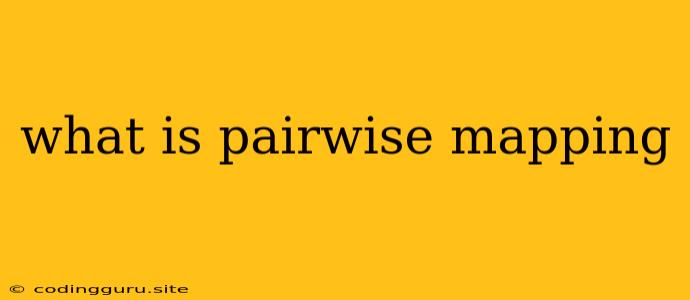What is Pairwise Mapping?
Pairwise mapping, also known as pairwise testing, is a software testing technique that aims to identify defects in software by systematically testing combinations of input values. This approach focuses on finding interactions between different input parameters, as these interactions can often lead to unexpected and sometimes critical bugs.
Let's break it down:
Imagine you have a software application with multiple input fields, such as a form with fields for name, age, and email. Each of these fields might have a variety of possible input values.
- Name: could be "John Doe", "Jane Doe", "12345", or even an empty string.
- Age: could be "25", "50", "100", or "-1".
- Email: could be a valid email address, an invalid email address, or a blank field.
Testing all possible combinations of these input values (e.g., "John Doe", "25", "valid email"), known as exhaustive testing, is often impractical due to the sheer number of combinations. This is where pairwise mapping comes in.
Pairwise mapping focuses on testing all possible pairs of input values. In our example, this means testing:
- Name ("John Doe") with Age ("25"), Name ("John Doe") with Email ("valid email"), Name ("John Doe") with Age ("50") and so on, for all possible pairings.
- Age ("25") with Email ("valid email"), Age ("25") with Email ("invalid email"), and so on.
By testing all possible pairs, pairwise mapping significantly reduces the number of test cases compared to exhaustive testing, while still covering a wide range of potential interactions.
How does pairwise mapping work?
Pairwise mapping algorithms analyze the input values and their combinations, then generate a set of test cases that ensure all possible pairs of values are tested. These algorithms are often implemented in specialized testing tools.
Benefits of Pairwise Mapping:
- Reduced testing effort: Compared to exhaustive testing, pairwise mapping significantly reduces the number of test cases, saving time and resources.
- Effective bug detection: Pairwise mapping effectively identifies defects that arise from interactions between different input values, which may not be detected by individual parameter testing.
- Increased test coverage: While not exhaustive, pairwise mapping achieves good test coverage by testing all possible pairs of input values, leading to higher confidence in the software's quality.
Example:
Let's say we have a simple form with two input fields:
- Field 1 (Color): Red, Blue, Green
- Field 2 (Size): Small, Medium, Large
Exhaustive testing would require 9 test cases (3 colors x 3 sizes). However, pairwise mapping can achieve good coverage with only 6 test cases:
- Red - Small
- Red - Medium
- Red - Large
- Blue - Small
- Blue - Large
- Green - Medium
This combination covers all possible pairs of colors and sizes.
Tips for Effective Pairwise Mapping:
- Identify key input fields: Focus on fields that are likely to have significant interactions.
- Choose relevant input values: Select a representative set of input values that cover the range of possibilities.
- Use a pairwise mapping tool: There are various tools available to automate the generation of pairwise test cases.
In summary, pairwise mapping is a powerful technique for software testing that effectively identifies defects arising from interactions between input parameters. It significantly reduces testing effort while providing good test coverage.
